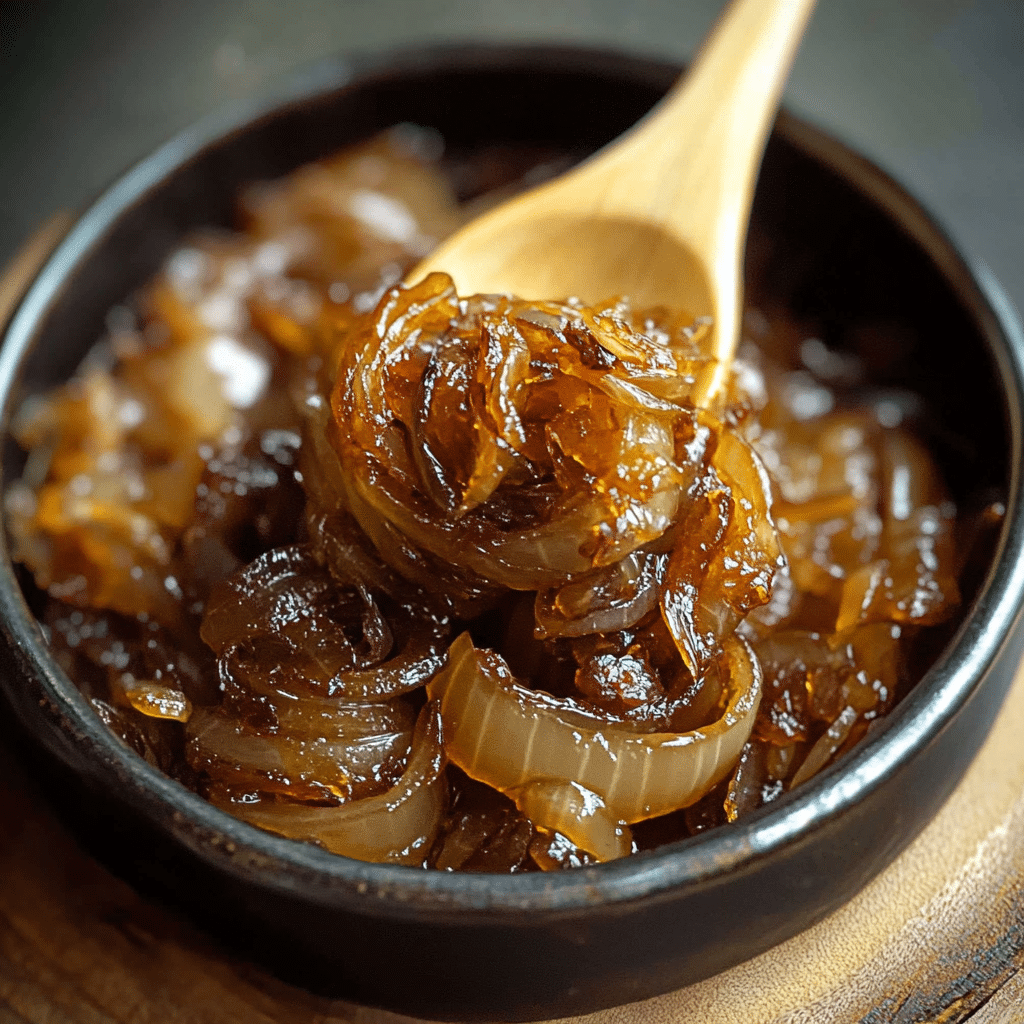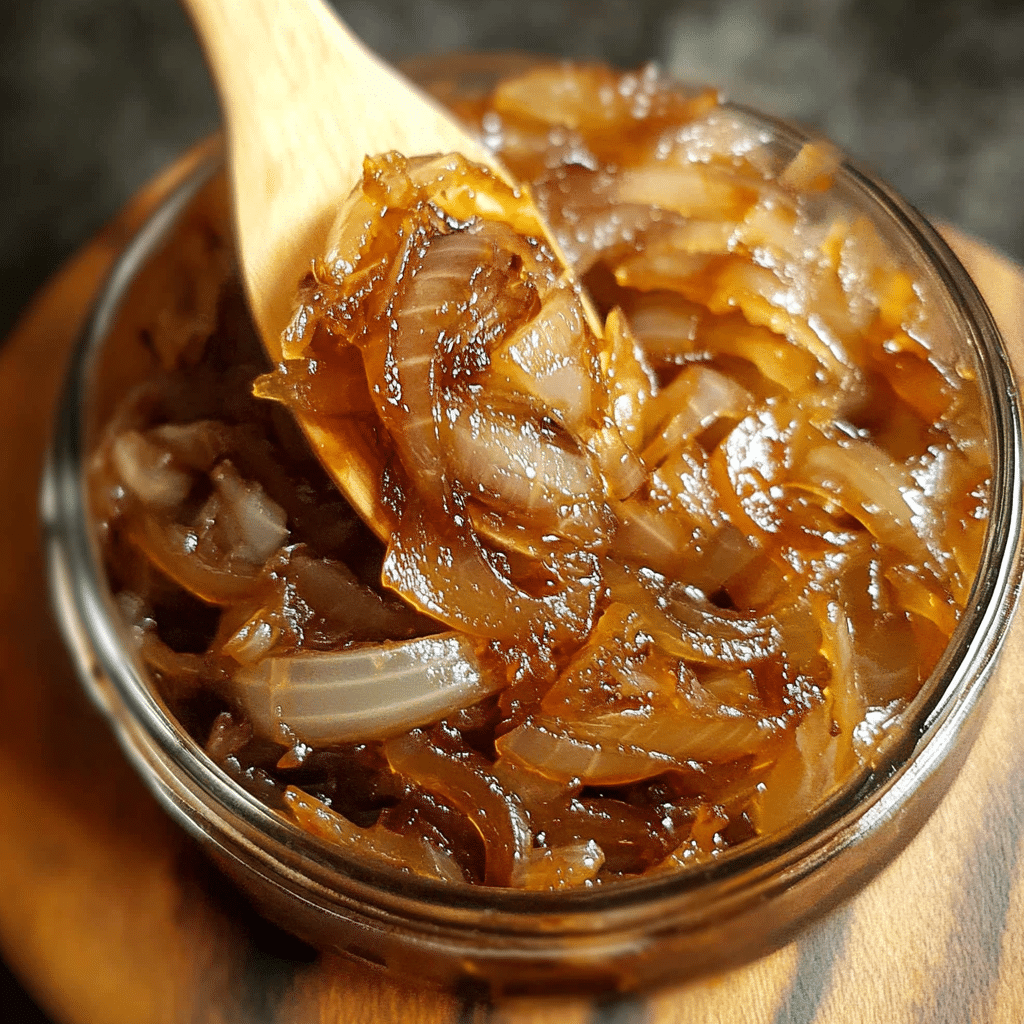
Caramelized onions are a rich, sweet, and savory addition to almost any dish, transforming the ordinary into something extraordinary. Slowly cooked over low heat, onions gradually soften and turn a beautiful golden-brown, developing a deep, sweet flavor that enhances everything from burgers to soups, pastas, and salads. Their mellow sweetness and umami notes make them an essential ingredient in many cuisines.
I first made caramelized onions when I was experimenting with adding depth to a simple dish, and they quickly became a kitchen staple. The slow cooking process filled the house with the most mouthwatering aroma, and the onions turned soft and glossy, with a hint of sweetness that perfectly balanced the savory flavors of the meal. Each bite was a little burst of flavor that made every dish it touched feel more special.
What I love about caramelized onions is how versatile they are. They can be made in large batches and stored for later use, allowing you to add them to anything from sandwiches to dips or even scrambled eggs. Whether you’re cooking for a crowd or just adding a little something extra to your dinner, caramelized onions are a simple, flavorful way to elevate your meals!
Perfect for:
- Topping burgers or sandwiches
- Adding flavor to soups and stews
- Mixing into pasta dishes
- Serving as a side dish
- Garnishing steaks or roasted meats
Why You’ll Love This Recipe
Here are 10 reasons why you’ll fall in love with Caramelized Onions:
- Sweet and Savory Flavor: The slow caramelization process turns onions into a sweet, savory delight.
- Simple Yet Flavorful: With just a few ingredients, these onions pack a punch in any dish.
- Rich and Tender Texture: The long cooking time transforms the onions into a melt-in-your-mouth texture.
- Perfect for Meal Prep: Caramelized onions store well in the fridge, so you can have them on hand for quick meals.
- Versatile Ingredient: Use them in a variety of dishes to add depth and complexity.
- Customizable: Adjust the sweetness and savory elements by adding ingredients like balsamic vinegar, brown sugar, or fresh herbs.
- Great for Batch Cooking: Make a big batch and store them for future use in salads, wraps, or casseroles.
- No Special Tools Needed: This recipe requires just a pan and a little patience—no complicated equipment needed.
- Enhances Any Meal: Whether it’s a casual meal or a gourmet dinner, these onions elevate your dishes instantly.
- Easy to Make Ahead: They can be prepared in advance and added to any meal for added convenience and flavor.
Preparation and Cooking Time
- Total Time: 1 hour
- Preparation Time: 10 minutes
- Cooking Time: 50 minutes
- Servings: 4 servings
- Calories per serving: Approximately 100-120 calories
- Key Nutrients: Carbs: 24g, Fat: 6g, Protein: 1g
Ingredients
For the Caramelized Onions:
- 2 large onions, thinly sliced
- 2 tablespoons olive oil or unsalted butter
- ½ teaspoon salt
- 1 tablespoon brown sugar (optional, for added sweetness)
- 1 tablespoon balsamic vinegar (optional, for extra depth)
- Fresh thyme or rosemary (optional, for extra flavor)
Ingredient Highlights
- Olive Oil or Butter: Provides a rich base for cooking the onions and helps them soften.
- Brown Sugar: Adds a touch of sweetness that enhances the caramelization process.
- Balsamic Vinegar: Adds tang and balances the sweetness of the onions.
- Fresh Herbs: Optional, but fresh thyme or rosemary can infuse the onions with extra depth.
Step-by-Step Instructions
Cook the Caramelized Onions:
- Heat the Pan: In a large skillet, heat olive oil or butter over medium-low heat.
- Add Onions: Add the thinly sliced onions and stir to coat with the oil or butter.
- Cook Slowly: Let the onions cook for 40-50 minutes, stirring occasionally. They should gradually soften, turn golden, and develop a deep, caramelized color.
- Add Seasonings: Stir in salt and brown sugar (if using) after about 20 minutes. The sugar will help enhance the caramelization process.
- Deglaze (Optional): For added flavor, pour in balsamic vinegar after the onions have caramelized, scraping up any browned bits from the bottom of the pan.
- Continue Cooking: Cook for another 5-10 minutes, allowing the onions to absorb the vinegar and deepen in flavor.
- Serve: Once the onions are golden, tender, and sweet, remove them from the pan and serve as a topping or side dish.

How to Serve
Here are 10 serving suggestions for Caramelized Onions:
- On Burgers: Top your burger with a generous helping of caramelized onions for a rich, savory flavor.
- With Steaks: Serve as a topping for grilled steaks or other meats to add depth.
- In Sandwiches: Add to sandwiches or wraps for an elevated flavor profile.
- In Soups: Stir into French onion soup or any other savory broth-based soup.
- On Pizzas: Use as a topping for gourmet pizzas, pairing with ingredients like goat cheese or arugula.
- In Pasta Dishes: Toss into pasta with a little garlic and cheese for a quick and delicious meal.
- On Toast: Spread on toast for a simple and satisfying snack.
- As a Side Dish: Serve alongside roasted vegetables or grilled meats.
- In Casseroles: Add caramelized onions to casseroles or baked dishes for a deeper flavor.
- With Eggs: Top scrambled eggs or omelets with caramelized onions for a savory breakfast.
Additional Tips
- Slow Cooking is Key: The key to perfectly caramelized onions is cooking them slowly over medium-low heat to allow the natural sugars to develop.
- Stir Occasionally: Stir the onions every 5 minutes or so to ensure they cook evenly and don’t burn.
- Watch for Burning: If the onions start to burn or stick to the pan, lower the heat or add a splash of water to deglaze the pan.
- Batch Cooking: These onions can be made in larger quantities and stored in the fridge for up to a week.
- Sweet or Savory: Adjust the amount of brown sugar to suit your taste. Add more for a sweeter onion, or leave it out for a more savory result.
Recipe Variations
- Balsamic Caramelized Onions: Add a splash of balsamic vinegar for an extra depth of flavor.
- Spicy Caramelized Onions: Add a pinch of red pepper flakes while cooking for a spicy kick.
- Garlic Caramelized Onions: Toss in minced garlic during the last 10 minutes of cooking for a garlicky twist.
- Herb-Infused Onions: Add fresh herbs like thyme, rosemary, or sage to infuse the onions with additional flavor.
- Vegan Option: Simply use olive oil instead of butter to keep the recipe vegan.
Special Equipment
- Skillet: A wide, heavy skillet ensures even cooking and caramelization of the onions.
- Wooden Spoon: Use to stir the onions without scratching the pan.
- Sharp Knife: A sharp knife helps to thinly slice the onions for even cooking.
FAQ Section
- Can I use red onions instead of yellow onions?
Yes, red onions will work, though they have a slightly milder flavor and will result in a darker color. - Can I make these in advance?
Yes, caramelized onions can be made ahead and stored in the fridge for up to 5 days. - Can I freeze caramelized onions?
Yes, you can freeze them for up to 3 months. Just let them cool completely before transferring them to an airtight container. - How can I prevent the onions from burning?
Cook them over low heat, and stir frequently. If necessary, add a splash of water to prevent burning. - Can I speed up the caramelization process?
While it’s best to cook slowly, you can increase the heat slightly to speed up the process—just be sure to stir often to prevent burning. - What can I use these onions for besides burgers?
They’re great in salads, on pizzas, in pasta, and even as a topping for roasted vegetables. - Can I add wine to caramelized onions?
Yes, you can deglaze the pan with a splash of white wine or red wine for an additional layer of flavor. - What’s the best way to store caramelized onions?
Store them in an airtight container in the fridge for up to 5 days or freeze them for longer storage. - Can I make caramelized onions without butter?
Yes, you can use olive oil for a dairy-free version. - Do I need to use brown sugar?
Brown sugar helps enhance the caramelization, but you can skip it for a more savory result.
Conclusion
Caramelized onions are a rich, sweet, and savory addition to any dish, transforming simple meals into something truly special. Slowly cooked over low heat, the onions turn golden-brown and tender, developing deep, caramelized flavors that are both sweet and savory. These onions can be used in everything from burgers and sandwiches to salads, pizzas, or pastas, adding a touch of depth and complexity to every bite.
The magic of caramelized onions is in the patience—the slow cooking process allows the natural sugars in the onions to break down, creating that perfect balance of sweetness and savory goodness. You can add a bit of balsamic vinegar, thyme, or a splash of wine for extra flavor, or even a pinch of salt and pepper to enhance the taste. Whether you make a big batch to keep on hand or use them fresh, caramelized onions are a versatile and delicious ingredient.
I can’t wait to see how your Caramelized Onions turn out! Snap a photo and share it on Instagram, tagging me so I can admire your savory creation. Don’t forget to leave a comment and let me know how you used them—I’d love to hear all about the delicious dishes you paired them with!
